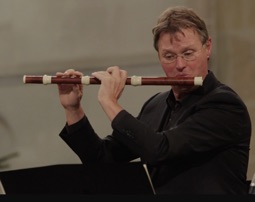
Copy or
own creation ?
Whilst all other flutes that come
from my workshop are reproductions,
as far as possible true to the original or reconstructions
from original instruments dating back to the 18th and 19th century,
the ‘Eigentopf’ flute is, as the name implies (in German ‘eigen’ means ‘own’),
rather my own creation than a copy of an instrument made by Eichentopf – the instrument maker from Leipzig.
The Original
Johann Heinrich Eichentopf (1678 – 1769) was a contemporary of Johann Sebastian Bach and like him lived and worked for a large period of his life in Leipzig. He is to be credited with the invention of the oboe da caccia – possibly inspired by Bach. Up till today primarily Eichentopfs’ Oboes have survived. Unfortunately we know of only one flute and this instrument has subsequently been altered so dramatically, that we can only, at the most, guess the original state.
The whole flute is made of ivory and belongs to the instrument museum of the University of Leipzig. In an effort to raise the original pitch of presumably lower than 400 Hz, all joints of the flute were shortened and most of the turning profiles were altered accordingly. Even worse - the original, presumably round embouchure hole, that was positioned very close to the end of the flute was sealed. It was then replaced by a more modern oval embouchure hole at another position. Normally a survey, with the prospect of a possible copy, would have finished here at the very latest – if it hadn’t been for the flutes’ highly unusual interior.
The conical bore has a remarkably slight taper and large spacings between the individual joints of the flute, which is a good indication of a very early four-part instrument. Although the cone, quite unusual, is also continued in the foot joint, the interior diameter of the flute at the end is surprisingly wide. As it can hardly be assumed that Eichentopf built an experimental prototype in precious ivory it is possible that the flute underlies a so far unknown concept.
The ‘Eigentopf’ Flute
Even though it was not possible, to make a serious copy of the Eichentopf flute, due to the many alterations to the original instrument, it still tempted me to try and see if this fascinating bore concept would even work at all and what the result would sound like.
As I, with this experiment, didn’t have to take the (anyway speculative) pitch of the original into consideration, I decided to align my ‘Eigentopf’ flute without compromise for today’s usual pitch of 415 Hz (see below). Thereby I allowed myself to be guided by the question of how Eichentopf would have proceeded, if he were requested, to transfer his design to this pitch.
I tried initially, based on the unchanged original position of the tone holes plus the obvious traces of the shortening, to determine the original proportions and then transfer these onto 415 Hz. The Flute contained a not too small, round and relatively steep walled embouchure hole.
Due to ivory being very heavy, the original Eichentopf flute was made with very thin walls. I decided to use very wide decorative rings made of heavy imitation ivory for my design to transfer this distinguished characteristic to a wooden flute. The dense material adds the needed mass to this otherwise slender instrument. This way, a very appealing balance between tone and resonance is produced, which even enhances the sound character of an early, only slightly conical flute.
This effect is particularly intensive when using boxwood. The tone is somewhat stronger and very elegant when using ebony. The heavier wood also offers a greater resistance towards the musician. Grenadilla gives the flute an even more assertive tone. However, the tone becomes slightly sharper and clearly less resonant.
Standard tuning 415Hz?
For many years 415Hz has been the standard pitch for Baroque music within the Early Music domain. This is highly surprising, when taking into consideration that there are hardly any surviving examples from the first third of the eighteenth century for this pitch. The majority of the remaining flutes are distinctly lower-pitched, around 400Hz, a pitch that is derided today as being exotic. At most we find instruments that have at least interchangeable center pieces (‘corps de rechange') for 415Hz, but in general those flutes work and sound much better with their longer center pieces.
Hence, the majority of musicians today - historical informed performance or not – play instruments of too late a date (e.g. Palanca, G.A.Rottenburgh, Grenser), use instruments with middle joints, that require unnecessary compromises (e.g. Denner) or rely from the start on instruments that, regarding their tone and volume, have been adjusted to “the modern requirements”, but possibly don’t have very much left in common with their historical models.
On the other hand, the 415Hz pitch is certainly not, in the first place, “un-historical”. After all, in the early 18th century noticeably higher tuned instruments were produced, such as the Castel flute shows. With this background, my ‘Eigentopf’ flute is neither a copy nor a complete own creation, but a suggestion of a flute, as how it could have been …
Fridtjof Aurin Traversflöten Düsseldorf
F. A. Eigentopf, Düsseldorf, 2016
boxwood , ebony or grenadilla
with silver key, a=415 Hz
Photo: Ulrich Ehret




Marten Root

